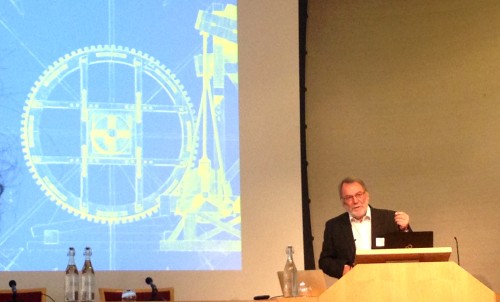
Futuristic views: Peter Knight opening the conference at the Royal Society in London. (Courtesy: Tushna Commissariat)
By Tushna Commissariat
Not a week goes by here at Physics World that we don’t cover some advance in quantum mechanics – be it another step towards quantum computing or error correction, or a new type of quantum sensor, or another basic principle being verified and tested at new scales. While each advance may not always be a breakthrough, it is fair to say that the field has grown by leaps and bound in the last 20 years or so. Indeed, it has seen at least two “revolutions” since it first began and is now poised on the brink of a third, as scientific groups and companies around the world race to build the first quantum computer.
With this in mind, some of the stalwarts of the field – including Peter Knight, Ian Walmsley, Gerard Milburn, Stephen Till and Jonathan Pritchard – organized a two-day discussion meeting at the Royal Society in London, titled “Quantum technology for the 21st century“, which I decided to attend. The meeting’s main aim was to bring together academic and industry leaders “in quantum physics and engineering to identify the next generation of quantum technologies for translational development”. As Knight said during his opening speech, the time has come to “balance the massive leaps that the science has made with actual practical technology”.
And the meeting did have a wide scope, with speakers talking about everything from quantum communication and information to quantum imaging and metrology. As it would be a rather long and cumbersome read if I tried to give you even a short description of each talk, I think, instead, I will pick out a few recurring themes that emerged over the course of the two days.
One of the most popular areas was that of metrology, timekeeping and navigation. Indeed, the first talk on day one kicked off with Ed Hinds of Imperial College London giving us an excellent run-through of how atom interferometry has developed since the 1900s and how current atomic interferometers “are stable, sensitive and precise”, which makes them useful for a variety of navigation and geodesy applications. They are also excellent devices for testing fundamental constants and properties, as described by Stanford’s Mark Kasevich, who built the first-ever atomic interferometer and is now working on tests of the equivalence principle using a 10 m-high tower and light-pulse atom interferometry. I did manage to catch up with both of them after their talks, so look out for an interview with them soon.
Another stalwart of the field, French physicist Alain Aspect was in attendance and he talked about doing quantum simulations using utracold atoms. This marriage of quantum mechanics and condensed-matter physics is definitely another growing trend as the two seemingly disparate fields look towards each other for inspiration and solutions. Aspect simulates everything from quantum conduction to many-body localization using cold atoms, which he describes as “wonderful”, adding that “we too are slow but not slower than the atoms and so we can do the measurements many times”.
When it came to the more industry-driven talks, Andrew Shields, who heads up Toshiba’s Quantum Information Group, and Kai Bongs, who director of the new UK National Quantum Technology Hub, both talked about defying the “valley of death” and developing practical devices and techniques. The main focus of the UK hub is to focus on quantum sensors that could be used in everything from defence to geophysics to medical diagnostics to construction to even naval navigation and data storage. Indeed, both Shields and Bongs referred to devices already on the market and how they were working to make them cheaper and even more accessible to large markets and mass production.
After their talks, I really couldn’t help but think that while graphene (and materials science) is still touted as the golden-child when it comes to technological development, we are yet to see the first practical industry-focused device that actually incorporates graphene. Quantum technologies, on the other hand, are already a step ahead and in the marketplace; even though, admittedly, quantum computers are still some years in the making.
Guidelines
Show/hide formatting guidelines
this text was deletedwhere people live in harmony with nature and animals</q>
Some text